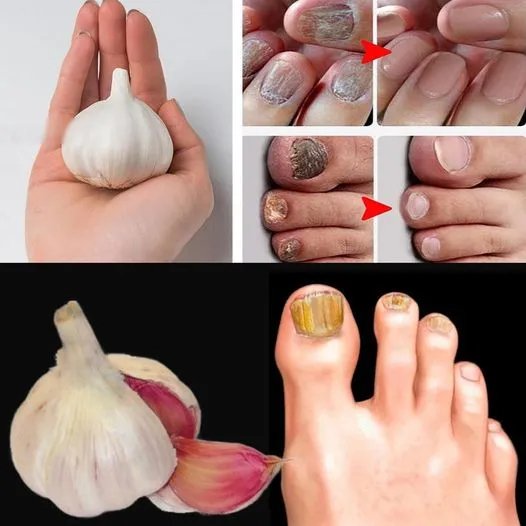Nail fungus is a common and often embarrassing problem that many people face, and it can affect both your nails and your self-confidence. It’s a fungal infection that causes nails to become thick, discolored, brittle, and sometimes painful. While over-the-counter antifungal creams and prescriptions are commonly used to treat the condition, they can be costly, come with side effects, and may not always be effective. However, there is a natural remedy that has been used for centuries to combat various health issues, including nail fungus: garlic.

Garlic, known scientifically as Allium sativum, has been revered for its medicinal properties for thousands of years. It has powerful antifungal, antibacterial, and antiviral properties that make it an excellent natural remedy for a variety of conditions. Garlic is particularly effective in treating nail fungus due to its active compounds, namely allicin, which is responsible for its potent antifungal activity. The allicin in garlic can inhibit the growth of the fungi that cause nail infections, ultimately helping to clear up the infection without the need for harsh chemicals or prescription drugs.
How Garlic Fights Nail Fungus
Garlic’s antifungal properties are what make it so effective in combating nail fungus. The active ingredient allicin is a sulfur-containing compound that is released when garlic is chopped, crushed, or chewed. This compound has been shown to kill a variety of fungi, including the type that commonly causes fungal nail infections, such as Trichophyton rubrum and Candida albicans.
When garlic is applied to the affected area, the allicin gets to work attacking the fungal cells, disrupting their ability to reproduce and thrive. Allicin works by penetrating the fungal cell walls, breaking down their structure, and interfering with their metabolism. This makes it difficult for the fungus to survive and spread. Additionally, garlic contains other compounds, like diallyl disulfide, that support immune function and help the body fight off infections naturally.
Ways to Use Garlic for Nail Fungus
There are several ways to use garlic to treat nail fungus, and all of them can be done easily at home with a few simple ingredients. Below are some of the most effective garlic-based remedies that can help clear up nail fungus:
1. Garlic Paste
One of the easiest and most direct ways to apply garlic to the infected nail is by creating a garlic paste. To do this, crush or finely chop a few garlic cloves and mash them into a paste-like consistency. You can add a small amount of olive oil or coconut oil to the paste to make it easier to apply and to help moisturize the skin around the nail.
How to Use:
-
Apply the garlic paste directly to the affected nail.
-
Cover the area with a bandage or gauze and leave it on for 30 minutes to an hour.
-
Rinse off with warm water and pat dry.
-
Repeat this treatment 2–3 times a day for several weeks, or until the fungus shows signs of improvement.
2. Garlic Soak
Another simple method is to soak the affected nails in a garlic-infused solution. This method allows the garlic’s antifungal properties to penetrate the nail bed more thoroughly. Garlic-infused water or oil can be made by steeping crushed garlic cloves in warm water or oil, allowing it to infuse for several hours.
How to Use:
-
Boil a cup of water and add a few crushed garlic cloves to it.
-
Let the mixture steep for 15–20 minutes.
-
Soak your affected nails in the garlic-infused water for 20–30 minutes.
-
Repeat this process daily until the infection starts to clear.
Alternatively, you can use garlic oil for a more concentrated solution. Simply add a few drops of garlic oil to a small bowl of warm water and soak your nails in it.
3. Garlic Oil Application
For those who prefer a more convenient option, garlic oil can be a great alternative. Garlic oil is widely available in health food stores, and it contains the concentrated form of the active compounds found in fresh garlic. You can also make your own garlic oil by infusing crushed garlic in olive oil or coconut oil.
How to Use:
-
Gently warm the garlic oil if it’s not already liquid.
-
Apply a few drops directly onto the infected nails and surrounding skin.
-
Massage the oil in for a few minutes, then leave it on.
-
Repeat this treatment 1–2 times daily until the infection subsides.
Garlic oil is less likely to irritate the skin than fresh garlic paste, making it a good option for those with sensitive skin or for those who want a quicker application method.
4. Garlic and Tea Tree Oil
Tea tree oil is another natural remedy known for its powerful antifungal properties. When combined with garlic, it creates a potent duo that can work wonders on nail fungus. Tea tree oil is often used in treating a variety of fungal infections, and when paired with garlic, it can enhance the antifungal effects and promote faster healing.
How to Use:
-
Mix equal parts of garlic oil and tea tree oil.
-
Apply the mixture directly to the affected nails using a cotton ball or cotton swab.
-
Leave it on for 30 minutes to an hour.
-
Rinse off and repeat the process 2–3 times a day.
5. Garlic and Vinegar Soak
Apple cider vinegar is another popular natural remedy for nail fungus. The acidity of vinegar helps to create an environment that is inhospitable to fungal growth, while the garlic adds an extra antifungal punch. This combination can help combat the infection more effectively.
How to Use:
-
Mix equal parts of apple cider vinegar and garlic-infused water or garlic oil.
-
Soak the infected nails in the solution for 20–30 minutes.
-
Repeat daily for best results.
Precautions When Using Garlic for Nail Fungus
While garlic is a natural remedy, it’s essential to use it with care. Garlic is potent, and if used improperly, it can cause skin irritation or burns, especially when applied in concentrated amounts.
-
Always perform a patch test before applying garlic directly to your skin. Apply a small amount of crushed garlic or garlic oil to a patch of healthy skin and wait 24 hours to see if any irritation occurs.
-
If you experience any redness, burning, or discomfort, discontinue use immediately.
-
If the infection is severe or spreads rapidly, it’s a good idea to consult with a healthcare provider before relying solely on natural remedies.
Why Garlic Works for Nail Fungus
Garlic has a long history of use as both a food and a medicine. It contains a variety of bioactive compounds that give it a wide range of health benefits, including combating fungal infections. Allicin, the compound most responsible for garlic’s antifungal properties, has been shown in numerous studies to effectively kill fungal pathogens, including those that cause nail fungus.
Nail fungus thrives in moist, warm environments and can be notoriously difficult to treat. However, by incorporating garlic into your treatment routine, you can effectively target the root cause of the infection and promote healing.
Conclusion
Nail fungus doesn’t have to be a lifelong problem. If you’re looking for a natural, affordable way to treat the condition, garlic may be just the solution you need. Its antifungal properties, combined with its ability to support overall health, make it an excellent choice for tackling stubborn fungal infections. Whether you choose to apply garlic paste, use garlic oil, or incorporate garlic into a soak, this powerful natural remedy can help you erase nail fungus and restore the health of your nails. So, if you’ve been struggling with nail fungus, it might be time to give garlic a try — your nails will thank you!

